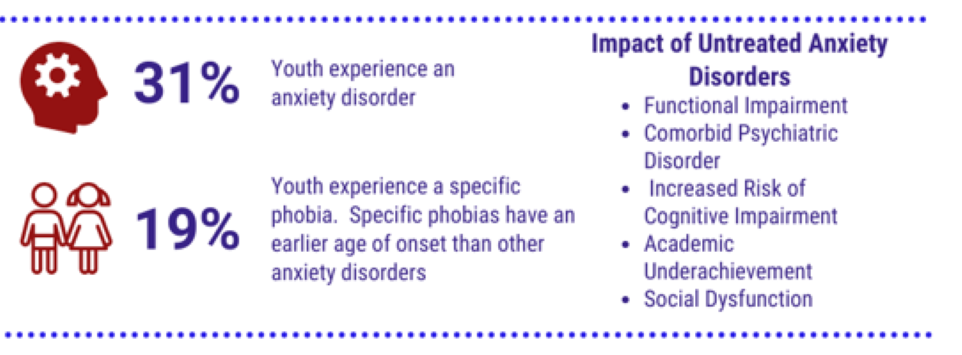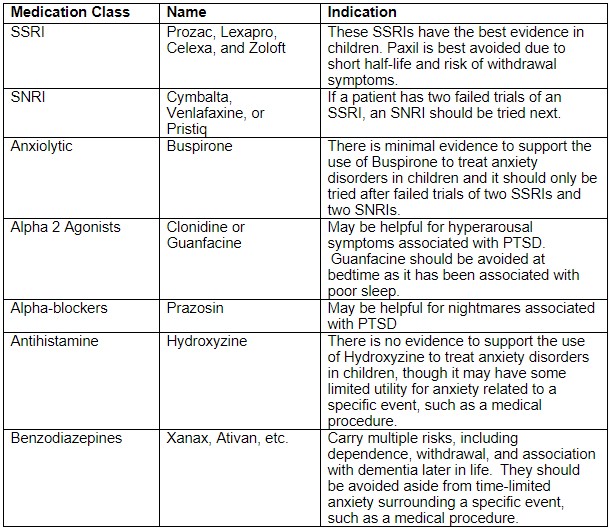Anxiety and Phobias
Anxiety and Phobia in Pediatrics

Types of Anxiety Disorders
Types of Anxiety Disorders
Generalized Anxiety Disorder
Children and adolescents with anxiety disorders experience distress about a variety of everyday and commonplace occurrences. These children often worry about everything which impacts all areas of their lives, including social interactions, school and home life. These children may often be described as “perfectionists” and have difficulty accepting less than a perfect performance at home, socially or at school. Youth experiencing generalized anxiety often seek reassurance from parents, caregivers or other adults in attempt to ease their feelings of stress. Some symptoms may include:
- Difficulty Concentrating
- Sleep Issues
- Irritability
- Fatigue
- Stomach Aches
- Headaches
Separation Anxiety Disorder
Difficulty separating from a parent or caregiver is a developmentally appropriate reaction for young children. However, when fear of being separated interferes with age appropriate development, assessment for separation anxiety disorder is warranted. Symptoms emerge in preschool age and early grammar school. However, older children may also experience separation anxiety. Symptoms may include:
- Difficulty saying goodbye
- Tantrums at separation
- Fear of bad outcomes upon separation from a parent or caregiver
- Insistence on keeping in touch with parents or caregivers during separation
- Avoidance of school or social activities
- Somatic symptoms such as headaches or stomachaches
Social Anxiety Disorder
Shyness and experiencing worry about new things and situations may be normative in most children and adolescents. However, shyness does not interfere with a child’s ability to participate in social situations. Children and adolescents who experience social anxiety disorder have a disproportionate response and fear of criticism from peers and others. These youth have difficulty in two main areas: performance and situations. For example, a child may have difficulty trying out for or participating in a sports team because of fear of judgement by peers and other adults. Youth that have difficulty in certain situations such as on public transportation or large crowds, may try to avoid these activities in order to prevent the anxiety from occurring.
Youth with social anxiety often experience physical symptoms such as sweating, shaking, flushing red, and difficulty breathing. Young children may express social anxiety through irritability or tantrums when faced with the situation or occurrence.
Children at risk of social anxiety disorder include a first degree family member with the disorder, children with a fear of negative evaluation and children who have modeled social anxiety from a parent or caregiver.
Specific Phobia
When a child or adolescent exhibits an irrational or disproportionate fear response to a specific thing, providers should consider an assessment for specific phobia. Children and adolescents may develop phobias after a traumatic experience with negative outcomes. For example a child who had a severe allergic reaction after being stung by a bee may develop a fear of going outside. Some children may also develop a phobia of something that is not perceived as dangerous, but their response impacts their functioning. It is not uncommon for children and adolescents to experience multiple phobias.
Risk factors for phobias include a first degree relative with specific phobias, children with negative affectivity, traumatic event, grief/loss, or a history of abuse.
In assessing for a specific phobia, consider the patient’s response, the presence of triggers, the level of impairment and the presence of anticipatory dread.
Panic Disorder
Children with panic disorders experience recurrent and unexpected panic attacks that consist of sudden and intense fear. Some children experience panic attacks unexpectedly and other children have a triggering event. Some symptoms may include:
- Palpatations
- Shortness of Breath
- Dizziness
- Sweating
- Feelings of Doom or Death
Children and adolescents who experience panic attacks will begin to feel anticipatory anxiety about when another panic attack will occur. Such anticipation may lead to avoidance of situations they know to trigger a panic attack or places where panic attacks occurred in the past.
Selective Mutism
Children with selective mutism do not have difficulty speaking in their home environment. However, when that same child is in school or other social situations, their fear prohibits them from speaking. Some children may go long stretches of time without speaking in school.
Screening
When screening children and adolescents for phobia or anxiety disorders obtain informaiotn from multiple informants, including teachers, coaches and family. Find free and evidence based screening tools on our website for use in the primary care office.
Treatment
Psychotherapy
Cognitive Behavior Therapy assists children in learning how to manage their symptoms using coping mechanisms. Some examples of coping mechanisms include breathing exercises, The goal of therapy is to help the patient gain skills so they may face situations that trigger anxiety or panic and reduce impact to their daily functioning.
Medication
Choosing when to use psychotropic medication for treatment can be challenging. Here are some tips for determining the appropriateness of medication for your patient:
- Severity of anxiety does not allow child to participate in psychotherapy
- Severe degree of impairment or distress
- Significant co-morbid depression or suicidal thoughts
- More than a single phobia
Cognitive Behavioral Therapy (CBT) treatment should be offered first for mild to moderate anxiety disorders. For moderate to severe anxiety disorders, The American Academy of Child and Adolescent Psychiatry (AACAP), recommends a combination of CBT and medication treatment as the most effective treatment for anxiety disorders (1). There are many validated measurement tools to assess anxiety severity.
The first-line medication for the treatment of pediatric anxiety is a SSRI (2). Prozac, Lexapro, Celexa, and Zoloft have the best evidence for treating anxiety in children (see the table below for more information). If a child suffers from both Major Depressive Disorder and any type of anxiety disorder, first-line treatment differs a bit from treatment of anxiety disorders alone. In this case, recommended SSRIs for comorbid depressive and anxiety disorders include fluoxetine, citalopram, and escitalopram.
Primary care providers do not have to make treatment decisions on their own. The board-certified child and adolescent psychiatrists with Illinois DocAssist can assist in making treatment recommendations for your patients. All consultations are free and easy to schedule. Call our intake line at 866-986-2778 Monday through Friday between 9:00 am and 5:00 pm or schedule a consultation here.
Resources for Providers
The Child Mind Institute offers guidance for educators in addressing and managing children with selective mutism in school.
The American Psychological Association offers recommended books for children experiencing fear and anxiety.
The Anxiety and Depression Association of America offers brochures to download on topics including social anxiety disorder, panic disorder and specific phobias.
Anxiety in the Classroom provides strategies for designing and implementing accommodations for children and adolescents with anxiety in the school setting.
Fear thermometers can assist patients in identifying feelings they are having in any given moment. Access this Fear Thermometer for use in the pediatric setting. Using the fear thermometer, patients can then create a fear hierarchy (“Fear Ladder“) to decide the order of exposures starting with the lowest-rated items and moving upward to the highest-rated.
Help your patients identify and manage symptoms related to their anxiety with a Symptom Management Plan.
Resources for your Patients and their Families
The American Academy of Child and Adolescent Psychiatry provides guidelines for anxiety medications for children and adolescents.
Online apps provide support and relaxation techniques for children and adolescents dealing with anxiety or phobias.
The Calm app offers CalmHealth to healthcare providers and their patients. The Calm app requires a subscription, however, there are free resources that can be downloaded such as intention cards, guides and calendars.
Find more apps for you patients through our resource page.
The American Academy of Child and Adolescent Psychiatry offers Facts for Families on The Anxious Child and Panic Disorder in Children and Adolescents.
That National Institute of Mental Health provides information on different kinds of anxiety disorders. Access brochures and shareable handouts on their website.
References:
1) JAACAP Practice Parameters Anxiety Disorders https://www.jaacap.org/article/S0890-8567(20)30280-X/fulltext
2) UpToDate Pharmacotherapy for anxiety disorders in children and adolescents: https://www.uptodate.com/contents/pharmacotherapy-for-anxiety-disorders-in-children-and-adolescents
Table 1:

Medications for Pediatric Anxiety Disorders
I’m So Stressed Out! Infographic!!
NIMH created a handout for adolescents and young adults to assist in differentiating between stress and anxiety, learning how to cope and when to access help